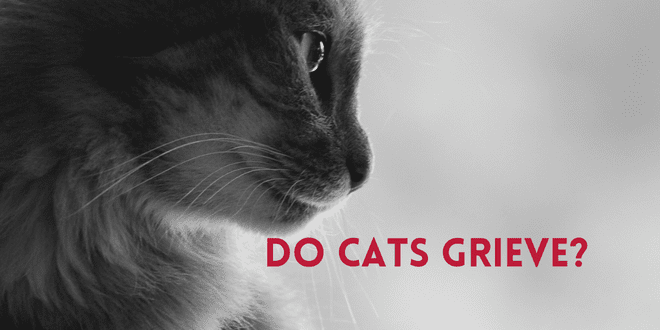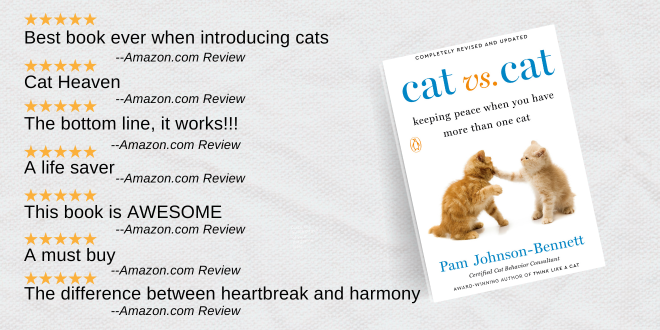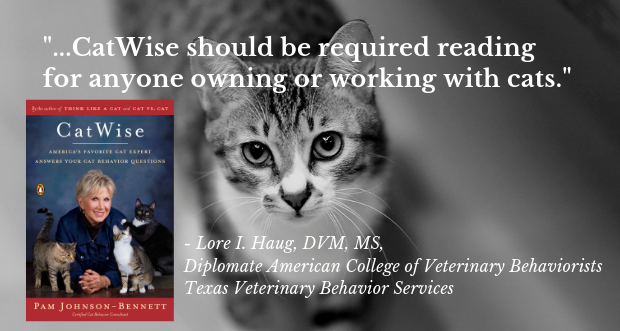
Many people don’t realize animals grieve the loss of companions and family members. Even if companion cats had a hostile relationship, the surviving cat may still grieve the loss. There’s confusion about where the other cat has gone. The cat, regardless of whether they were close or not, had negotiated territories within the household and now the surviving cat has to figure out whether to risk crossing onto that cat’s turf.
The Household Dynamic
To add to the initial grief of the surviving cat, there’s the fact that human family members are acting distraught. Cats take comfort in predictability and they depend on their human family members to behave the same way each day. As the human grieves the loss of a pet, the household dynamic changes and the grieving cat picks up on the elevated stress level. When the cat sees the cat parent crying and stressed out, it sends a red flag that everything in his world has turned upside down. During your own grieving time, you may also be more at risk of neglecting normal routines so mealtime may end up being late, pets don’t get played with as often, and general interaction with surviving pets can become tense. You may clutch and hold onto your cat desperately as you grieve. The message that gets sent to the cat is one of restraint and confusion, and not affection and love.
Here are some tips for you to help your cat through the grieving process:
Monitor Your Cat’s Routine
Observe your cat’s eating and litter box habits. It’s not unusual for a grieving cat to stop eating or to experience a change in litter box habits. If you notice either of these, contact your veterinarian. It’s very dangerous for a cat to go two days without eating because of the very serious risk of liver damage.
Watch that your cat doesn’t fall into a depression. Stay in contact with your veterinarian if you’re at all in doubt about how your cat is handling the loss of a companion or family member. Your veterinarian may give your a referral to a veterinary behaviorist or certified cat behavior consultant.
When grieving a loss, it’s not uncommon for a cat to experience a change in eating habits, altered sleeping patterns, a strong desire to stay physically closer to human family members, and he may even walk through the house in an attempt to find his missing companion. Keep an eye on behavioral changes as well as changes in eating, grooming, and litter box habits to make sure the situation doesn’t become serious or dangerous. Everybody, whether human, feline, or canine, grieves differently. Your best tool is the fact that you know your cat’s typical patterns and behavior so you can be alerted to potentially dangerous changes.
Maintain a Normal Schedule for Your Cat
Even if your cat’s appetite has decreased or doesn’t seem as interested in interacting with you, it’s important to keep schedules as normal as possible. Engage in your typical schedule of interactive playtime, even if your cat doesn’t seem as enthusiastic. When it comes to meals, this is the time to maintain good nutrition so resist the urge to entice your cat to eat by offering unhealthy treats or introducing a change in food. Make the meal as appealing as possible, so don’t leave canned food out in the dish to harden. Serve wet food at room temperature or slightly warmer to release enticing aromas. If you free-feed dry food, keep track of how much you put in the bowl so you’ll be aware of whether the cat is eating the normal amount. If several family members are responsible for filling the dry food bowl it can be easy to lose track of how much is actually getting eaten. Designate one person to replenish the free-choice feeding bowl so amounts can be monitored. Stay in touch with your veterinarian for guidance if your cat stops eating.
Monitor Your Own Behavior for Your Cat’s Sake
When you grieve, it’s normal to want to hold dearly to family members and companion animals as you cry. It’s a typical way for giving and receiving comfort. When it comes to your cat, be aware of whether the affection you give borders on clutching and clinging in a way that sends out warning signals. Your cat is very sensitive to your emotions and too much clinging can create anxiety. Even though playtime and more fun activities may be the last thing you want to do, it’s important to help prevent your cat from falling into a depression or becoming more stressed.
Create a Memorial
This is something that may help the human family process grieving, which will then help the surviving cat. If you feel you have a way to honor the cat who has passed, it may create more comfort for you. This can be especially helpful for children in the family who can easily feel left out and confused by what’s occurring in the household after the death of a pet. Anything you can do, whether it’s to create a special garden, photo album, or even honoring the cat by making a donation to an animal welfare organization, may provide a little more comfort and peace for you. The surviving cat, being such a sensitive animal, will benefit from any body language signal of peace and comfort you display.
Don’t be too Quick to Bring in Another Cat
In an effort to prevent the cat from being lonely, or to try to ease family members’ pain, it’s common for the grieving human to want to bring home another pet. This can become a recipe for disaster. The grieving cat may not be emotionally ready to handle the intrusion of an unfamiliar animal in the home. Territorial aggression could rear its head up in a big way. Cat introductions, under the best of circumstances, require good timing and positive associations. If the resident cat is in the middle of grieving for a lost companion, it puts the newcomer cat in a no-win situation.
Don’t rush to fill an empty space left by the cat who recently passed away. The best thing you can do for your surviving cat is to offer time with you in a normal way. The cat needs a familiar routine. Your cat needs to know not everything in his world has turned upside down and that much of the daily routine is still the same.
After allowing whatever time is needed for grieving, you may, at some point, determine your surviving cat would benefit from the addition of another companion animal. It’s then you can begin the gradual, positive introduction. Don’t rush to get to this point though. Take your cues from your cat so you can be sure he is over their grief. It’s also important you and your family members have processed through the grief as well so that when/if you do decide to add another cat, the newcomer has a good chance of being loved and accepted for who they are, without comparisons to the cat who passed.
In a Multipet Home, Allow Time for Adjustments in Dynamics
In multipet homes, each relationship is unique and the pets have worked out a way of time-sharing in the environment. Even if there was hostility over territorial rights, the death of a pet causes an upset in that normal routine. The surviving animals need time to renegotiate territory, become comfortable again within any social groups, and establish a new dynamic. Relationships may shift a bit during this time of uncertainty. Monitor to make sure no one gets picked on or ostracized, but let them have space as they find their new “normal.”
Carefully and Gently Introduce Neutral Items for Your Cat
While you certainly don’t want to make major changes to the environment, it may be helpful to bring in a new interactive toy to spark some playtime interest or even a cozy bed to place by a sunny window. Maybe the addition of a new cat tree, or some cat shelves will add a little spark to the environment.
 https://catbehaviorassociates.com/buy-pams-books/
https://catbehaviorassociates.com/buy-pams-books/
Don’t Rush Your Cat
We’re all individual in not only the way we grieve but how long we grieve. You may notice your cat seems back to normal in just a few days or it could take weeks or months. If it seems as if your cat is unable to find that spark in life again, talk to your veterinarian. You may need a referral to a veterinary behaviorist or other certified behavior expert at that point.
Need More Help?
For more specifics on cat behavior and training, refer to the best-selling books by Pam Johnson-Bennett. Her books are available in bookstores and online. We’ve included links to Amazon here on our website.
If you have a question regarding your cat’s health, please contact your veterinarian. This article is not intended as a replacement for your cat’s veterinary care.




